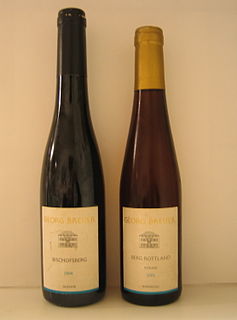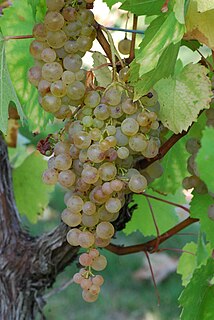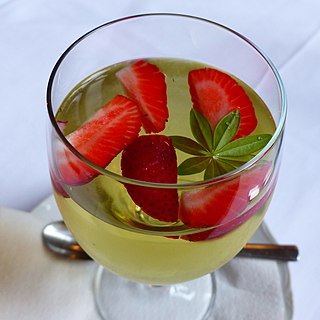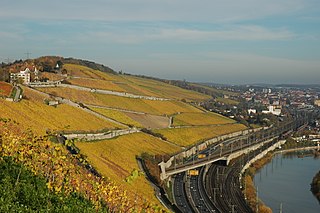 W
WGerman wine is primarily produced in the west of Germany, along the river Rhine and its tributaries, with the oldest plantations going back to the Roman era. Approximately 60 percent of German wine is produced in the state of Rhineland-Palatinate, where 6 of the 13 regions (Anbaugebiete) for quality wine are situated. Germany has about 103,000 hectares of vineyard, which is around one tenth of the vineyard surface in Spain, France or Italy. The total wine production is usually around 10 million hectoliters annually, corresponding to 1.3 billion bottles, which places Germany as the eighth-largest wine-producing country in the world. White wine accounts for almost two thirds of the total production.
 W
WAuslese is a German language wine term for a late harvest wine and is a riper category than Spätlese in the Prädikatswein category of the Austrian and German wine classification. The grapes are picked from selected very ripe bunches in the autumn, and have to be hand-picked. Generally Auslese wine can be made in only the best harvest years that have been sufficiently warm. A small proportion of the grapes may be affected by noble rot in some regions although this never dominates the character of the wine. Rheingau winemaker Schloss Johannisberg is generally credited with discovering Auslese wine in 1787.
 W
WSonja Christ-Brendemühl, from the German wine region of Mosel ("Moselle"), was chosen as the German Wine Queen on 9 Oct 2009 in the city of Heilbronn, as the successor to Marlies Dumbsky from the Franconian wine region. The Wine Princesses during her twelve-month reign were Christl Schäfer (Württemberg) and Isabell Kindle (Baden). She is Germany's 61st Wine Queen.
 W
WMarlies Dumbsky, from the German wine region of Franconia, was the 2008/09 German Wine Queen. She was chosen on 10 October 2008 in the wine town of Neustadt an der Weinstraße as the successor to Evelyn Schmidt from Radebeul in Saxony as Germany's 60th national Wine Queen. The two wine princesses during her reign were Andrea Köninger from Baden and Sarah Schmitt from the Nahe.
 W
WFederweisser, is an alcoholic beverage, typically 9% alcohol by volume, although versions of up to 13.5% alcohol by volume are not uncommon. It is the product of fermented freshly pressed grape juice, known as must. The term in principle includes all stages of fermentation from must to finished wine.
 W
WFlurbereinigung is the German word best translated as land consolidation. Unlike the land reforms carried out in the socialist countries of the Eastern Bloc, including East Germany, the idea of Flurbereiningung was not so much to distribute large quasi-feudal holdings to the formerly landless rural workers and/or to Kolkhoz-style cooperatives, but rather to correct the situation where after centuries of equal division of the inheritance of small farmers among their heirs and unregulated sales, most farmers owned many small non-adjacent plots of land, making access and cultivation difficult and inefficient. Two other European countries where this kind of land reform has been carried out are France (remembrement) and the Netherlands (ruilverkaveling).
 W
WThe Franconian Wine Queen is the annually-elected representative of the German wine region of Franconia. At the end of her time in office, she is eligible to participate in the competition for the German Wine Queen. Until 1963, the Franconian Wine Queen reigned for two years.
 W
WA division of grape varieties into Frankish and Hunnic grape varieties was practiced in German-speaking countries in the Middle Ages and separated varieties considered to be better from those considered to be lesser. Frankish (fränkisch) grapes were considered noble grapes, and the designation derived from the Franks, as popular belief held that those were grapes introduced by Charlemagne or at least through his edicts. Hunnic grapes, on the other hand, were the simpler varieties.
 W
WA number of German wine auctions are held each year, where the premier German wine producers auction off some of the best young wines, as well as some older wines. Most auctions are arranged by the regional associations of Verband Deutscher Prädikats- und Qualitätsweingüter (VDP). These auctions differ from wine auctions on the second-hand market held by auction houses, where collectible wines are sold by private or corporate owners, since it is "first hand" wines that are sold.
 W
WThe German wine classification system puts a strong emphasis on standardization and factual completeness, and was first implemented by the German Wine Law of 1971. Nearly all of Germany's vineyards are delineated and registered as one of approximately 2,600 Einzellagen, and the produce from any vineyard can be used to make German wine at any quality level, as long as the must weight of the grapes reaches the designated minimum level. As the current German system does not classify vineyards by quality, the measure of wine ’quality’ is the ripeness of the grapes alone.
 W
WThe German Wine Princesses are the deputies of the German Wine Queen. Each year, up to three runners up in the German Wine Queen competition are awarded the title of "Wine Princess". Like the Wine Queen, they then become national and international representatives of the German wine industry under the direction of the German Wine Institute.
 W
WThe German Wine Queen is the representative of the German wine industry. She is elected, usually in the Palatine town of Neustadt an der Weinstraße, for a period of one year. The title is competed for by the regional wine queens of the thirteen German wine regions producing "quality" wine.
 W
WGerman wine regions are classified according to the quality category of the wine grown therein: Tafelwein, Landwein, Qualitätswein bestimmter Anbaugebiete (QbA) and Prädikatswein. The wine regions allowed to produce QbA and Prädikatswein are further subdivided into four categories according to size: Anbaugebiet, Bereich, Großlage and Einzellage. A small number of Einzellagen do not belong to a Großlage and are called "großlagenfrei", but all belong to a Bereich and Anbaugebiet.
 W
WGouais blanc or Weißer Heunisch is a white grape variety that is seldom grown today but is important as the ancestor of many traditional French and German grape varieties. The name Gouais derives from the old French adjective ‘gou’, a term of derision befitting its traditional status as the grape of the peasants. Likewise, the German name Weißer Heunisch labels it as one of the lesser "Hunnic" grapes.
 W
WHock is a British term for German white wine; sometimes it refers to white wine from the Rhine region and sometimes to all German white wine. The word hock is short for the obsolete word hockamore, an alteration of "Hochheimer", derived from the name of the town of Hochheim am Main in Germany.
 W
WIce wine is a type of dessert wine produced from grapes that have been frozen while still on the vine. The sugars and other dissolved solids do not freeze, but the water does, allowing for a more concentrated grape juice to develop. The grapes' must is then pressed from the frozen grapes, resulting in a smaller amount of more concentrated, very sweet wine. With ice wines, the freezing happens before the fermentation, not afterwards. Unlike the grapes from which other dessert wines are made, such as Sauternes, Tokaji, or Trockenbeerenauslese, ice wine grapes should not be affected by Botrytis cinerea or noble rot, at least not to any great degree. Only healthy grapes keep in good shape until the opportunity arises for an ice wine harvest, which in extreme cases can occur after the New Year, on a northern hemisphere calendar. This gives ice wine its characteristic refreshing sweetness balanced by high acidity. When the grapes are free of Botrytis, they are said to come in "clean".
 W
WKabinett, or sometimes Kabinettwein, is a German language wine term for a wine which is made from fully ripened grapes of the main harvest, typically picked in September, and are usually made in a light style. In the German wine classification system, Kabinett is the lowest level of Prädikatswein, lower in ripeness than Spätlese.
 W
WKanzler is a white German wine grape variety that was produced in the city of Alzey as a crossing of Müller-Thurgau and Silvaner. Today it is primarily grown in the Rheinhessen where it is valued for the high must weights that the grapes can achieve. However, the grape is very sensitive to terroir and vineyard site selection with a tendency to produce very low yields in unfavorable locations.
 W
WKopskiekelwein was a currant wine produced in the former German province of East Prussia.
 W
WLiebfraumilch or Liebfrauenmilch is a style of semi-sweet white German wine which may be produced, mostly for export, in the regions Rheinhessen, Palatinate, Rheingau, and Nahe. The original German spelling of the word is Liebfrauenmilch, given to the wine produced from the vineyards of the Liebfrauenkirche or "Church of Our Lady" in the Rhineland-Palatinate city of Worms since the eighteenth century. The spelling Liebfraumilch is more common on labels of exported wine.
 W
WMay wine, also known as Maitrank, Maiwein, Maibowle and Waldmeisterbowle, is the name of a German beverage that uses aromatized wine as a base. May wine is served in the spring, traditionally on the May Day holiday. The base is made by steeping the fragrant creeping herb sweet woodruff that grows in the forests of Northern Europe in a white German wine. It is the specialty of the town of Arlon, in the south of Belgium.
 W
WMuscat Ottonel or Muskat-Ottonel is a white wine grape variety that is a member of the Muscat family of Vitis vinifera. It is most notable for its use in dessert wines from Austria, Bulgaria, Romania, Croatia and Serbia as well as dry wines from Alsace and Hungary. In Alsace, the varietal designation Muscat d'Alsace is allowed for the varieties Muscat Ottonel, Muscat blanc à petit grains and Muscat rose à petit grains blended in any combination -or not-, and blends between these are not allowed for most Alsace Grands Crus.
 W
WNadine Poss, from Windesheim in the German wine region of Nahe, was chosen as the 65th German Wine Queen on 13 Sep 2013 in Offenburg, as the successor to Julia Bertram from the Ahr wine region. She thus became the eighth German Wine Queen from the Nahe. The wine princesses during her twelve-month reign are Ramona Diegel (Rheinhessen) and Sabine Wagner (Rheingau). The German Wine Queen is traditionally crowned in the town of Neustadt an der Weinstraße. By exception that year the ceremony took place in Offenburg. The occasion was the 100th anniversary of the Baden Vintners' Association.
 W
WSpätlese is a German wine term for a wine from fully ripe grapes, the lightest of the late harvest wines. Spätlese is a riper category than Kabinett in the Prädikatswein category of the German wine classification and is the lowest level of Prädikatswein in Austria, where Kabinett is classified in another way. In both cases, Spätlese is below Auslese in terms of ripeness. The grapes are picked at least seven days after normal harvest, so they are riper and have a higher sugar content. Because of the weather, waiting to pick the grapes later carries a risk of the crop being ruined by rain. However, in warm years and from good sites much of the harvest will reach Spätlese level.
 W
WA Strausse or Strausswirtschaft is a type of wine tavern in winegrowing areas of German-speaking countries that is only open during certain times of the year. Typically it is a pub run by winegrowers and winemakers themselves, in which they sell their own wine directly to the public. The food served needs to be simple, regional cold dishes. Other expressions like Besenwirtschaft and Besenschänke, Rädlewirtschaft as well as Hecken- or Häckerwirtschaft are also common.
Trockenbeerenauslese is a German language wine term for a medium to full body dessert wine.
 W
WVerband Deutscher Prädikats- und Qualitätsweingüter e.V. or the Association of German Prädikat Wine Estates, is an organisation where most of Germany's top wine producers are members. It is commonly known under its acronym VDP. Its membership includes about 200 wine estates and it was founded in 1910 as Verband Deutscher Naturweinversteigerer e.V., Association of German Natural Wine Auctioneers. It consists of 13 regional associations, one for each region in the German wine classification system.
 W
WWürzburger Stein is a vineyard in the German wine region of Franconia that has been producing a style of wine, known as Steinwein since at least the 8th century. Located on a hill overlooking the Main river outside the city of Würzburg, the vineyard is responsible for what may have been the oldest wine ever tasted. In addition to being one of Germany's oldest winemaking sites, at 85 hectares, the vineyard is also one of Germany's largest individual plots.